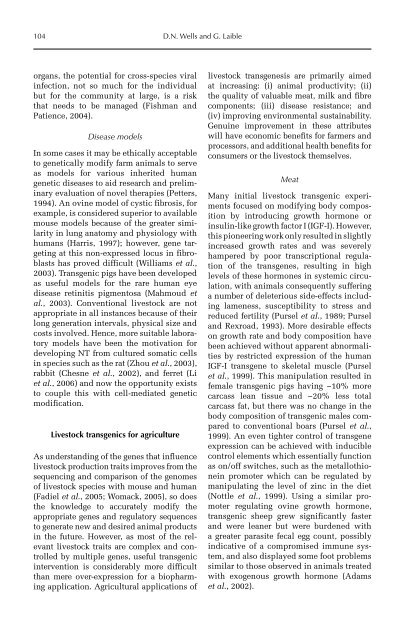Redesigning Animal Agriculture
Redesigning Animal Agriculture
Redesigning Animal Agriculture
You also want an ePaper? Increase the reach of your titles
YUMPU automatically turns print PDFs into web optimized ePapers that Google loves.
104 D.N. Wells and G. Laible<br />
organs, the potential for cross-species viral<br />
infection, not so much for the individual<br />
but for the community at large, is a risk<br />
that needs to be managed (Fishman and<br />
Patience, 2004).<br />
Disease models<br />
In some cases it may be ethically acceptable<br />
to genetically modify farm animals to serve<br />
as models for various inherited human<br />
genetic diseases to aid research and preliminary<br />
evaluation of novel therapies (Petters,<br />
1994). An ovine model of cystic fibrosis, for<br />
example, is considered superior to available<br />
mouse models because of the greater similarity<br />
in lung anatomy and physiology with<br />
humans (Harris, 1997); however, gene targeting<br />
at this non-expressed locus in fibroblasts<br />
has proved difficult (Williams et al.,<br />
2003). Transgenic pigs have been de veloped<br />
as useful models for the rare human eye<br />
disease retinitis pigmentosa (Mahmoud et<br />
al., 2003). Conventional livestock are not<br />
appropriate in all instances because of their<br />
long generation intervals, physical size and<br />
costs involved. Hence, more suitable laboratory<br />
models have been the motivation for<br />
developing NT from cultured somatic cells<br />
in species such as the rat (Zhou et al., 2003),<br />
rabbit (Chesne et al., 2002), and ferret (Li<br />
et al., 2006) and now the opportunity exists<br />
to couple this with cell-mediated genetic<br />
modification.<br />
Livestock transgenics for agriculture<br />
As understanding of the genes that influence<br />
livestock production traits improves from the<br />
sequencing and comparison of the genomes<br />
of livestock species with mouse and human<br />
(Fadiel et al., 2005; Womack, 2005), so does<br />
the knowledge to accurately modify the<br />
appropriate genes and regulatory sequences<br />
to generate new and desired animal products<br />
in the future. However, as most of the relevant<br />
livestock traits are complex and controlled<br />
by multiple genes, useful transgenic<br />
intervention is considerably more difficult<br />
than mere over-expression for a biopharming<br />
application. Agricultural applications of<br />
livestock transgenesis are primarily aimed<br />
at increasing: (i) animal productivity; (ii)<br />
the quality of valuable meat, milk and fibre<br />
components; (iii) disease resistance; and<br />
(iv) improving environmental sustainability.<br />
Genuine improvement in these attributes<br />
will have economic benefits for farmers and<br />
processors, and additional health benefits for<br />
consumers or the livestock themselves.<br />
Meat<br />
Many initial livestock transgenic experiments<br />
focused on modifying body composition<br />
by introducing growth hormone or<br />
insulin-like growth factor I (IGF-I). However,<br />
this pioneering work only resulted in slightly<br />
increased growth rates and was severely<br />
hampered by poor transcriptional regulation<br />
of the transgenes, resulting in high<br />
levels of these hormones in systemic circulation,<br />
with animals consequently suffering<br />
a number of deleterious side-effects including<br />
lameness, susceptibility to stress and<br />
reduced fertility (Pursel et al., 1989; Pursel<br />
and Rexroad, 1993). More desirable effects<br />
on growth rate and body composition have<br />
been achieved without apparent abnormalities<br />
by restricted expression of the human<br />
IGF-I transgene to skeletal muscle (Pursel<br />
et al., 1999). This manipulation resulted in<br />
female transgenic pigs having ~10% more<br />
carcass lean tissue and ~20% less total<br />
carcass fat, but there was no change in the<br />
body composition of transgenic males compared<br />
to conventional boars (Pursel et al.,<br />
1999). An even tighter control of transgene<br />
expression can be achieved with inducible<br />
control elements which essentially function<br />
as on/off switches, such as the metallothionein<br />
promoter which can be regulated by<br />
manipulating the level of zinc in the diet<br />
(Nottle et al., 1999). Using a similar promoter<br />
regulating ovine growth hormone,<br />
transgenic sheep grew significantly faster<br />
and were leaner but were burdened with<br />
a greater parasite fecal egg count, possibly<br />
indicative of a compromised immune system,<br />
and also displayed some foot problems<br />
similar to those observed in animals treated<br />
with exogenous growth hormone (Adams<br />
et al., 2002).










